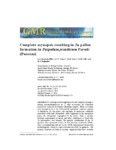Please use this identifier to cite or link to this item:
http://www.alice.cnptia.embrapa.br/alice/handle/doc/983777| Title: | Complete asynapsis resulting in 2n pollen formation in Paspalum jesuiticum Parodi (Poaceae). |
| Authors: | BERNARDO FILHO, R. A.  SANTOS, A. C. C.   SOUZA, F. H. D. de   VALLS, J. F. M.   PAGLIARINI, M. S.   |
| Affiliation: | R. A. BERNARDO FILHO, Universidade Estadual de Maringá A. C. C. SANTOS, Universidade Estadual de Maringá FRANCISCO HUMBERTO DUBBERN DE SOUZA, CPPSE JOSE FRANCISCO MONTENEGRO VALLS, CENARGEN M. S. PAGLIARINI, Universidade Estadual de Maringá. |
| Date Issued: | 2014 |
| Citation: | Genetics and Molecular Research, v. 13, n. 1, p. 255-261, jan. 2014. |
| Description: | Cytological investigation revealed complete asynapsis during microsporogenesis in 2 wild accessions of Paspalum jesuiticum collected in distinct Brazilian regions. Both accessions were hexaploid (2n = 6x = 60) and 60 univalents could be counted at diakinesis. In this phase, the majority of meiocytes exhibited univalents with both chromatids. After alignment at the metaphase plate, the chromatids segregated to the poles. Only 1 meiotic division (equational) occurred, and after cytokinesis, a dyad with 2n microspores was formed. The genetic constitution of the 2n gametes was equivalent to that of first division restitution (FDR). Since recombination did not occur, 100% transmission of parental heterozygosity could be expected from the FDR 2n gametes. The meiotic behavior of both accessions suggested that they resulted from a recent natural hybridization event. The potential use of the 2n gametes in Paspalum breeding programs has been discussed. |
| NAL Thesaurus: | Poaceae hexaploidy interspecific hybridization meiosis polyploidy |
| DOI: | 10.4238/2014.January.17.9 |
| Type of Material: | Artigo de periódico |
| Access: | openAccess |
| Appears in Collections: | Artigo em periódico indexado (CPPSE)  |
Files in This Item:
| File | Description | Size | Format | |
|---|---|---|---|---|
| PROCI2014.00009.pdf | 438,24 kB | Adobe PDF |  View/Open |









